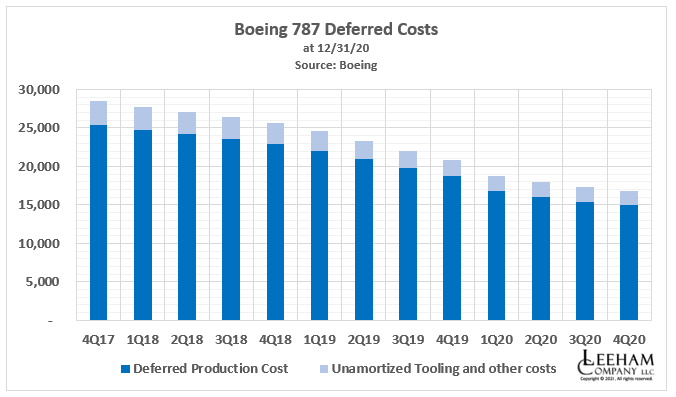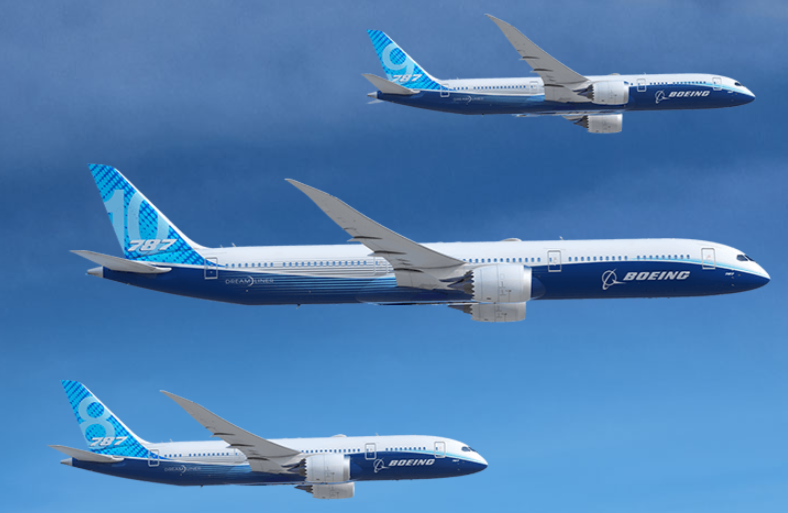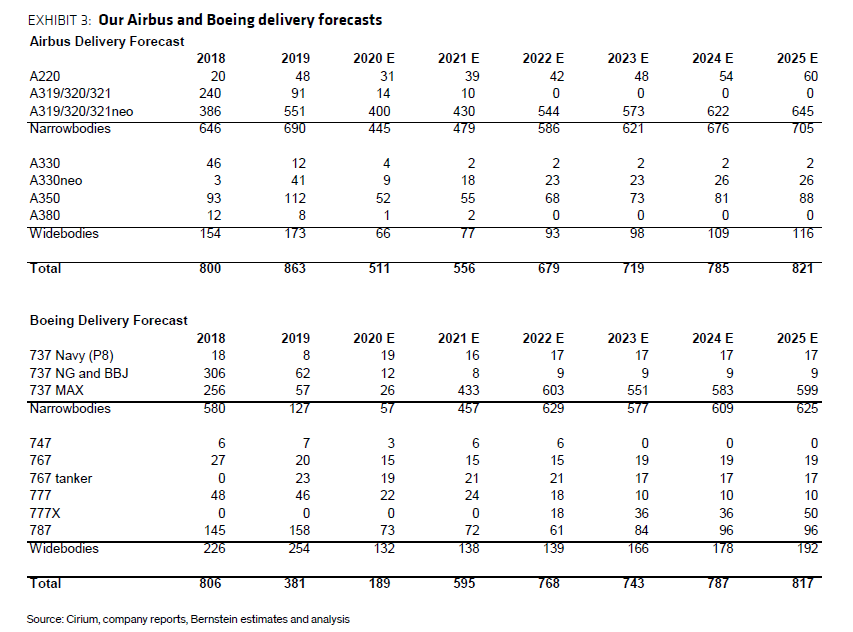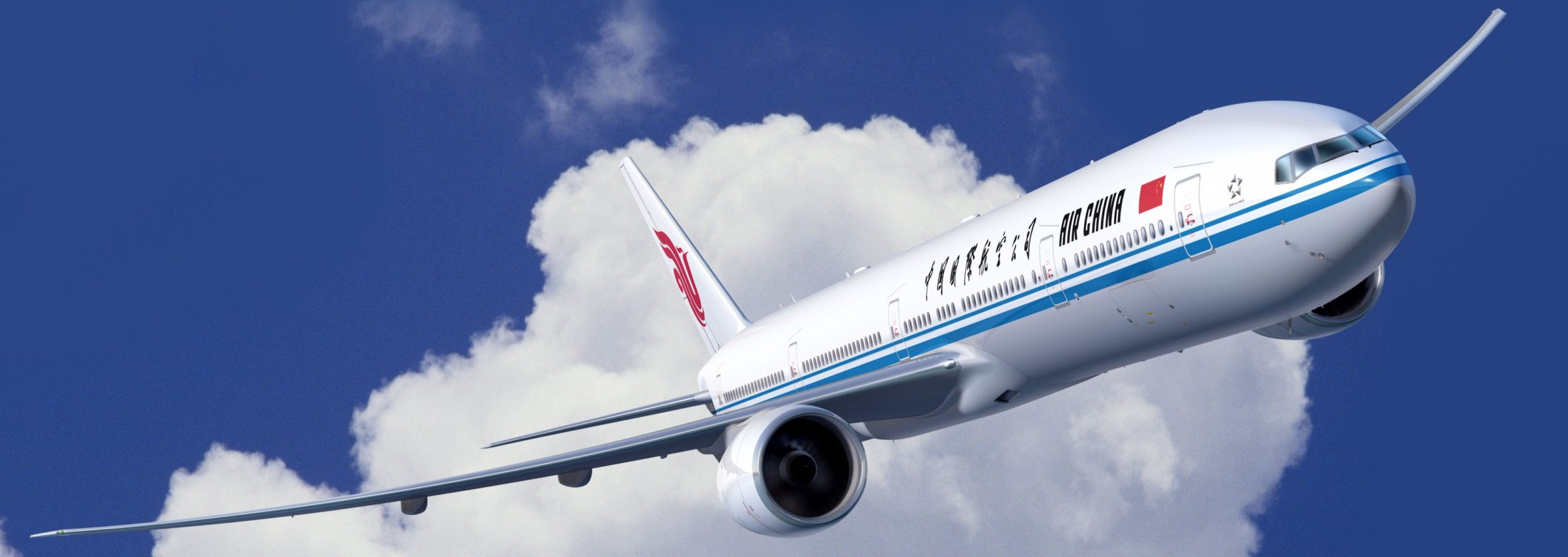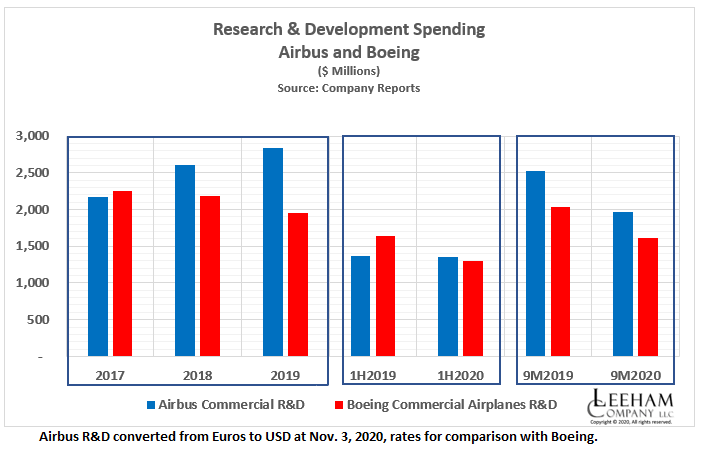Leeham News and Analysis
There's more to real news than a news release.
HOTR: Boeing continues to burn off deferred charges
By the Leeham News Team
Jan. 29, 2021, © Leeham News: With all the headlines about Boeing’s record-breaking 2020 loss and the $6.5bn forward loss for the 777X program, there was one item overlooked.
Boeing continues to reduce the deferred production costs for the 787. This is despite reducing production last year and suspending deliveries from October.
Deferred costs continued to come down quarter-over-quarter. Peaking at more than $32bn years ago, the total now is $16.6bn.
HOTR: Boeing could further cut 787 production rate—JP Morgan
By the Leeham News Staff
Jan. 20, 2021, © Leeham News: There is risk of another production rate cut for the 787, JP Morgan wrote in a Jan. 12 note.
Boeing already is reducing the rate to 5/mo this year. There are an estimated 60 787s in inventory due to production and quality control issues discovered last year that halted deliveries in November-December.
HOTR: Some predictions for Airbus and Boeing
Jan. 14, 2021, © Leeham News: Making predictions is always a hazardous business.
Some predictions take years to resolve. The outcome of others come sooner than later. If you’re right, you look sage. If you’re wrong, you look like an idiot.
But HOTR is going to take a stab at it anyway.
HOTR: Narrowbody delivery recovery in 2025
By the Leeham News Team
Dec. 15, 2020, © Leeham News: “We do not expect Airbus or Boeing to get back to planned narrowbody deliveries (adjust for MAX grounding) before 2025, with widebody deliveries taking much longer.”
That’s the view of Bernstein Research in a note published Dec. 14. It is a pessimistic view that belies the hopes of others in the industry.
Boeing officials said they hope to deliver about half the ~450 stored MAXes in 2021. Most of the remaining stored aircraft will deliver in 2022. There will be some spillover into 2023, Boeing said.
On this basis, Bernstein’s forecast suggests Boeing will deliver about 208 new-production MAXes in 2021. This computes to a production rate of 17/mo. The current rate is 6/mo, according to a Wall Street analyst. A rate break to 10/mo is expected soon.
In 2022, the Bernstein data suggests Boeing will deliver about 378 new-production MAXes. This is a production rate of about 31/mo. Boeing said it hopes to be at rate 31 in “early 2022.”
HOTR: Boeing hopes for break in China order drought after electors vote for Biden:
By the Leeham News Team
Nov. 30, 2020, © Leeham News: Boeing hopes the three-year order drought from China may come to an end next month.
The order, according to market intelligence, would be a boost for the slow-selling 777X. It could also mean new orders for the 787. Orders for the latter dropped significantly enough to prompt Boeing’s decision to shutter the Everett 787 production line next year. Production for the 787 will be consolidated in Charleston (SC).
Dec. 14 is when US presidential electors meet to cast their votes for Joe Biden or President Donald Trump, making official the projected winner. Biden won 306 electoral votes to Trump’s 232 in projections by all the major media. With almost all votes counted—and in some cases, recounted—Biden has 51.1% of the vote to Trump’s 47.2%. Biden received 80.1m votes to Trump’s 73.9m. The margin was nearly 6.2m.
China hasn’t ordered a Boeing airplane since 2017. Trump launched a trade war with China that escalated several times. He charged, without evidence, that China interfered with the US presidential election.
HOTR: New workforce newsletter; the return of Airchives
By the Leeham News Team
Nov. 12, 2020, © Leeham News: A new on-line newsletter, Future Aviation/Aerospace Workforce News, was launched last week  focusing on industry regulatory, corporate, training, recruitment and retention challenges.
focusing on industry regulatory, corporate, training, recruitment and retention challenges.
Created by Kathryn Creedy, a decades-long aviation writer and a contributor to LNA, the newsletter tackles workforce issues that long have received superficial coverage.
 Boeing, for as long as can be remembered, issued annual forecasts about the need for pilots and mechanics over the next decade. As the workforce aged, the numbers grew in each category to hundreds of thousands.
Boeing, for as long as can be remembered, issued annual forecasts about the need for pilots and mechanics over the next decade. As the workforce aged, the numbers grew in each category to hundreds of thousands.
The regional airline industry has long had challenges finding pilots.
Now, with COVID-19, cutbacks and bankruptcies upend the workforce.
Creedy’s new publication tackles these issues and more.
HOTR: Don’t get over-optimistic on COVID-19 vaccine news
By the Leeham News team
Nov. 10, 2020, © Leeham News: Pfizer yesterday announced it’s on track to produce a COVID-19 vaccine that appears to be 90% effective in trials. The company is one of the world’s leading drug makers.
This is good news.
 But before jumping to the old cliché about a light at the end of the tunnel, LNA’s Judson Rollins cautions, do the math.
But before jumping to the old cliché about a light at the end of the tunnel, LNA’s Judson Rollins cautions, do the math.
“Read the fine print at the end of the press release,” Rollins says.
“Based on current projections, we expect to produce globally up to 50m vaccine doses in 2020 and up to 1.3b doses in 2021,” the press release says.
“It’s a two-dose vaccine, so divide by two to figure the number of people who could be immunized,” Rollins says. “Even if a second candidate is approved and can be produced in the same quantity next year, that means just 17% of the world’s population will be vaccinated. And that assumes everything goes according to plan.”
Rollins did an extensive analysis of how quickly global air traffic would return to normal. In his July 13 post, Rollins projected that traffic won’t fully recover until 2024 at the earliest or 2028 at the latest. It all depends on how quickly a vaccine was developed, how quickly it could be distributed globally and how quickly people had confidence in it.
“We’re in only the second or maybe third inning of a very long ball game,” Rollins says. “Vaccines kill off a virus by denying it bodies in which to reproduce. If you don’t innoculate enough of the population while immunity lasts, you’re back to square one.”
HOTR: Airbus, Boeing R&D spending continues decline
By the Leeham News Team
Nov. 5, 2020, © Leeham News: Research and Development spending by the Airbus and Boeing commercial units declined year-over-year.
The movement is in keeping with cost-cutting by the Big Two OEMs. For Airbus, the reduction is due to the coronavirus pandemic. For Boeing, it’s due  to the 737 MAX grounding and the pandemic.
to the 737 MAX grounding and the pandemic.
Boeing’s spending typically lags Airbus. Richard Aboulafia, a consultant with Teal Group, for years criticized Boeing over its smaller spending, favoring instead shareholder value. Airbus overtook Boeing is innovative single-aisle airplane development years ago. Boeing’s choice of creating a 777 derivative instead of a new design to compete with the A350-1000 proved to be a weak move. There are only a handful of customers and the skyline is weak.
HOTR: With MAX nearing recertification, Boeing has bigger problem
By the Leeham News team
Oct. 27, 2020, © Leeham News: Boeing’s 737 MAX may be nearing recertification and airlines worry about passenger acceptance.
 But Boeing’s larger MAX problem is its general product line-up.
But Boeing’s larger MAX problem is its general product line-up.
LNA pointed out the poor sales of the 7 MAX in the past. We’ve also compared the lagging sales of the 9 MAX and 10 MAX compared with the A321neo.
As a result of the MAX grounding and now COVID-19’s disastrous financial impact on airlines around the world, more than 1,000 orders have been canceled or reclassified as iffy under the ASC 606 accounting rule.
Airbus doesn’t publicly reclassify the European equivalent of ASC 606. But LNA in July estimated how many A320s would be similarly classified. At that time, about 425 appeared to be similarly subject to ASC 606 if this accounting rule was applied to Airbus.
HOTR: What Delta and Qatar Airways have in common
By the Leeham News team
Oct. 6, 2020, © Leeham News: Apart from a few exceptions, airlines have had to take steep losses since the beginning of the COVID-19. The pain is compounded for two major airlines: Delta Air Lines and Qatar Airways.
Both airlines invested sizable amounts of money into other airlines. Qatar did so with external financing and Delta via reinvestments of profits. With the COVID-19 crisis, both airlines have had to record significant losses on those investments.


